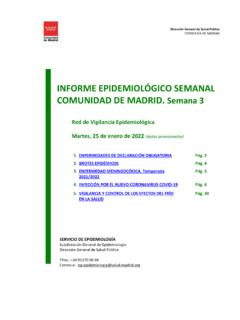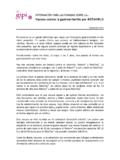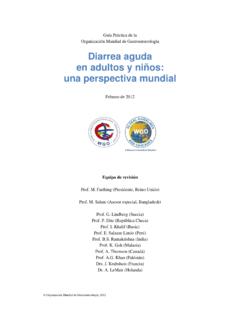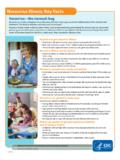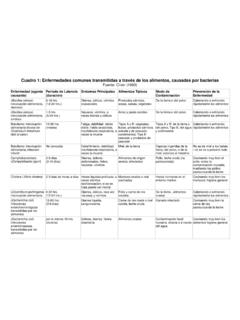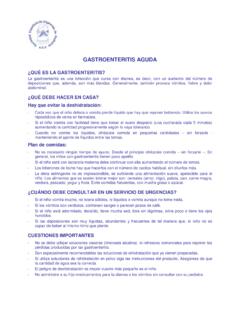Transcription of Signs and Symptoms small and Dissemination to the
1 Salmonella in the Caribbean - 2013 Infection with Salmonella Salmonellosis is one of the most common foodborne infections in the United States, resulting in an estimated million human cases and $365 million in direct medical costs annually (2011 estimates). Signs and Symptoms When Salmonella bacteria are ingested, they pass through a person s stomach and colonize the small and large intestine. There, the bacteria invade the intestinal mucosa and proliferate. The bacteria can invade the lymphoid tissues of the gastrointestinal tract and spread to the bloodstream. Dissemination to the bloodstream depends on host factors and virulence of the Salmonella strain and occurs in less than 5% of infections. If the infection spreads to the bloodstream, any organ can become infected ( , liver, gallbladder, bones, or meninges). The incubation period for salmonellosis is approximately 12 72 hours, but it can be longer.
2 Salmonella gastroenteritis is characterized by the sudden onset of diarrhea (sometime blood-tinged), abdominal cramps fever, and occasionally nausea and vomiting. Illness usually lasts 4 7 days. If the infection spreads to the bloodstream and distant organs, the illness increases in duration and severity and will usually include Signs and Symptoms related to the organ affected. A small proportion of persons infected with Salmonella develop reactive arthritis as a long-term sequela of the infection. Diagnosis Multiple diseases can cause fever, diarrhea, and abdominal cramps. Therefore, salmonellosis cannot be diagnosed on the basis of Symptoms alone. To diagnose salmonellosis, the bacterium is usually isolated in the laboratory from the patient's stool. The genus Salmonella is identified by using a series of biochemical tests. Subtyping ( , serotyping, pulsed field gel electrophoresis, and other tests) and antimicrobial susceptibility testing of Salmonella isolates are important adjuncts to the diagnostic testing of patients.
3 Both provide insights into the epidemiology of the patient s infection. Antimicrobial susceptibility testing also provides valuable information in the treatment of the patient, if use of antibiotics is deemed appropriate. The need for laboratory testing to diagnose infection with Salmonella affects our understanding of the occurrence of salmonellosis in the community. To be laboratory-confirmed: The patient must seek medical care. A specimen must be collected while the patient is still shedding the organism. Appropriate laboratory cultures must be performed. Only about of Salmonella infections in the United States are laboratory-confirmed; the proportion is likely lower in many other countries. Furthermore, because patients from whom specimens are collected are likely to be sicker and have better access to health care than patients from whom specimens are not collected, 2 Salmonella in the Caribbean - 2013 Infection with Salmonella these patients might not be representative of all patients with the infection.
4 Therefore, statistics on laboratory-confirmed Salmonella infections should be interpreted carefully. Treatment Salmonellosis is generally self-limited and usually does not require specific treatment. Persons with severe diarrhea might require rehydration, sometimes with intravenous fluids. Antibiotics are not recommended for uncomplicated cases and are only used if the infection spreads or is highly likely to spread from the intestines to the bloodstream and other organs. Transmission Salmonella is spread by the fecal-oral route and can be transmitted by food and water, by direct animal contact, and rarely from person-to-person. An estimated 94% of salmonellosis is transmitted by food. Humans usually become infected by eating foods contaminated with feces from an infected animal. As a result, implicated foods are often of animal origin such as beef, poultry, milk, and eggs.
5 Any food, however, can become contaminated through cross-contamination, environmental contamination, or by the unwashed hands of food workers. Outbreaks of salmonellosis have been traced to a variety of foods including cantaloupe with rinds that were likely contaminated in the field; alfalfa sprouts grown from contaminated seed; and tomatoes contaminated before or during harvest. Furthermore, food items are not always the source of Salmonella infection. Direct contact with pet turtles, iguanas, and chicks has been associated with human infection with Salmonella. Dissection of owl pellets was identified as the source of Salmonella outbreaks at two schools. And a number of years ago, an outbreak of Salmonella Muenchen was associated with exposure to marijuana! Because Salmonella must survive the high acid content of the stomach and compete with other bacteria in the gut to colonize the small and large intestine, a relatively large inoculum of Salmonella is often necessary to produce Symptoms .
6 However, foods that protect the bacteria from the action of the stomach's acid and a number of host factors can increase a person's susceptibility to infection and lower the infectious dose. Host factors that Increase Susceptibility to Salmonellosis High gastric pH (low acidity)* Gastric and gastrointestinal surgery** Antibiotic administration** Hemoglobin abnormalities ( , sickle cell anemia) Cancers Leukemia and lymphoma Diabetes mellitus Immunosuppressive drugs Acquired Immunodeficiency Syndrome (AIDS) *Normal gastric acidity (pH< ) is lethal to Salmonella. **Surgery can inhibit normal gastric emptying and intestinal motility and can be undertaken to reduce gastric acidity. **Antibiotics alter normal intestinal microflora. Control Because the major reservoirs for human Salmonella infection are poultry and livestock, reducing the number of Salmonella harbored in these animals will substantially reduce human exposure.
7 In Denmark, all animal feeds are treated to kill Salmonella before distribution to prevent spread of infection. Food animal flocks and herds are routinely tested for Salmonella and those found to be positive are sent for special slaughter followed by heat treatment of the meat. 3 Salmonella in the Caribbean - 2013 Infection with Salmonella In the United States, similar flock-based control measures are used by the egg industry to control Salmonella Enteritidis. Poultry houses are routinely cleaned and disinfected, care is taken to control pests and rodents, and feed is procured from safe sources. In addition, chickens are routinely tested for Salmonella Enteritidis. Infected breeder flocks are eliminated and eggs from infected egg-laying chickens are diverted to pasteurization. Basic food safety precautions are key in controlling salmonellosis. These measures include protecting processed foods from contamination and cooking and refrigerating foods adequately to prevent survival and growth of Salmonella.
8 Food workers and consumers should be educated about the need to cook meats, poultry, and eggs thoroughly and the need to wash hands and utensils with soap and water immediately after they have been in contact with raw meat, poultry, or eggs. Pasteurization of milk, hygienic slaughter practices, and thorough cooking of those foods can reduce the risk of becoming ill. Some serotypes of Salmonella are more resistant to antibiotics. Some of these antibiotics are the same as or similar to those used in humans and have major implications for treatment of human infections, when antibiotics are deemed necessary. Judicious use of antibiotics among both humans and animals is imperative in the control of this pathogen. Finally, subtyping of isolates and integrating enteric disease surveillance programs are critical to Salmonella control efforts. By examining results of Salmonella subtyping from food animals, environmental samples, and humans, public health officials can draw conclusions about sources of human infection and focus control efforts accordingly.
9










